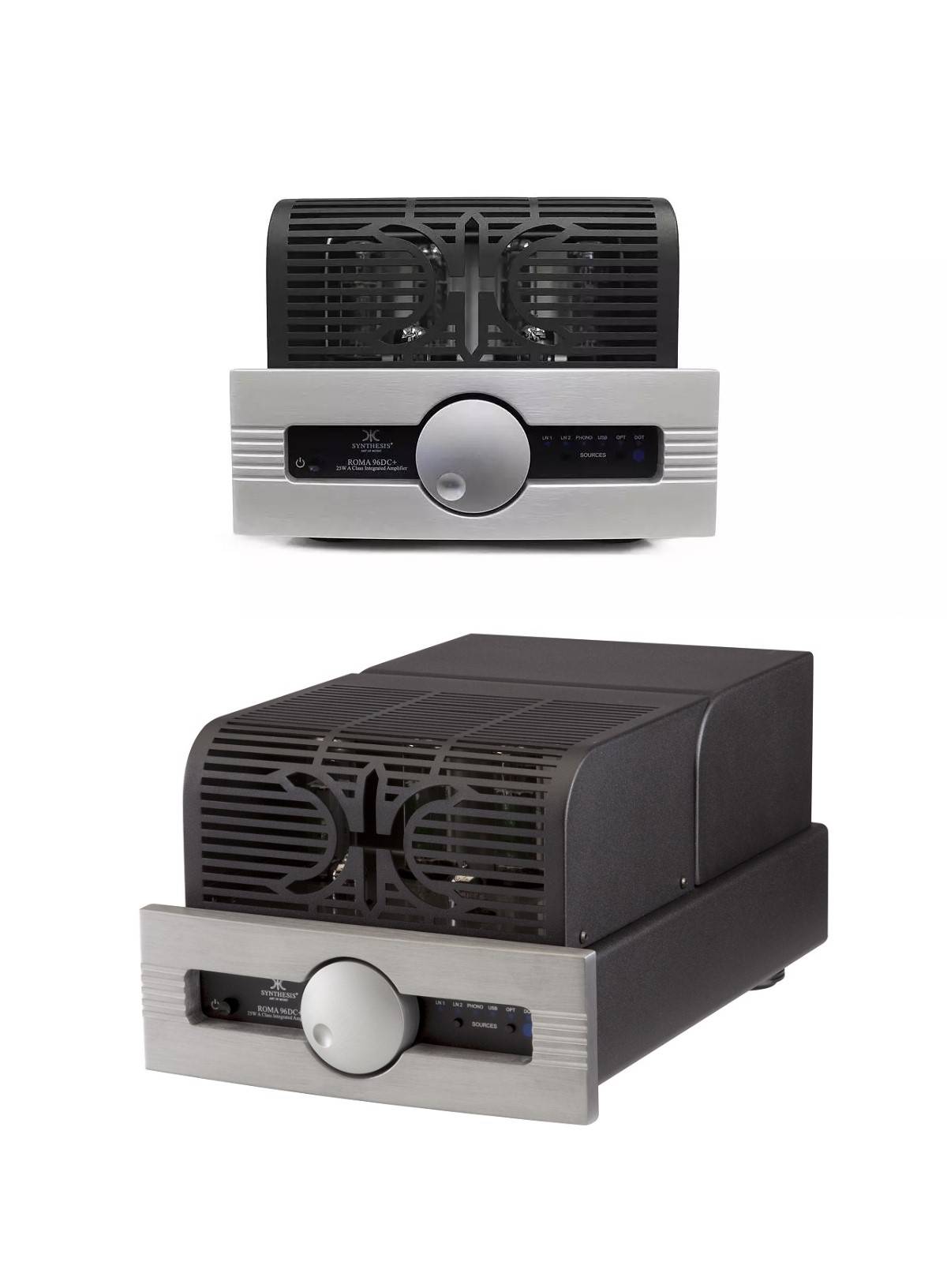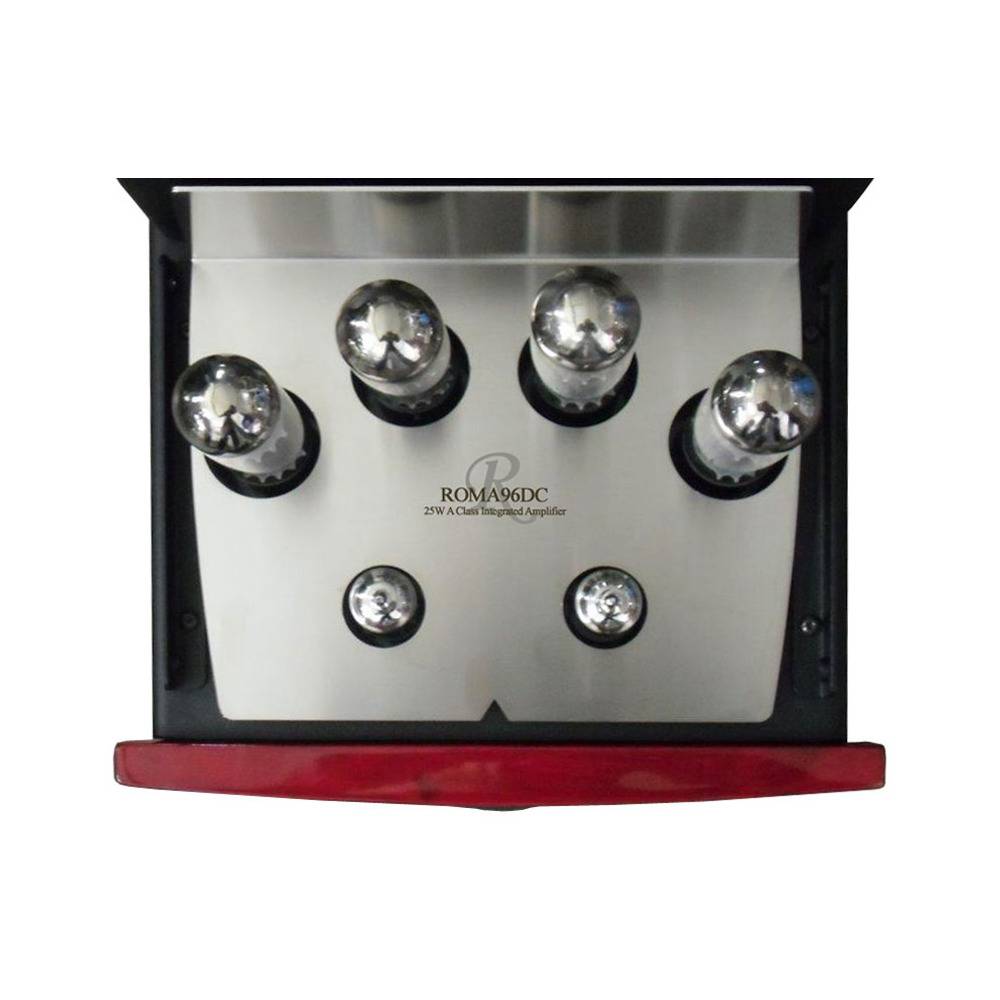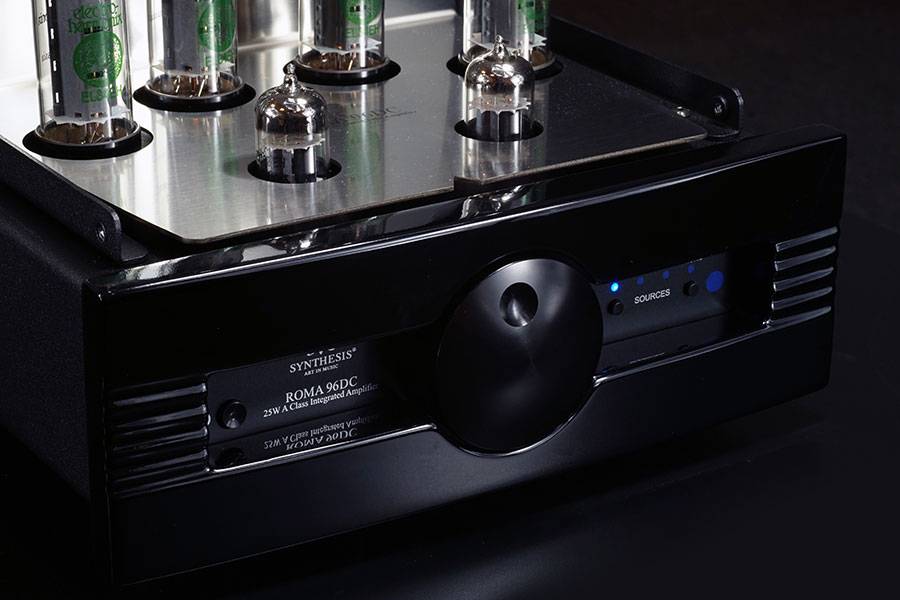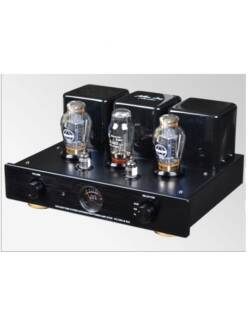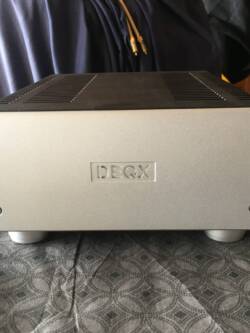Synthesis Roma 96DC 25W Pure A Class Integrated Stereo Amplifier
Original price was: R49,000.00.R28,000.00Current price is: R28,000.00.
Synthesis
Roma 96DC+ Integrated Amplifier
£2,649
The Synthesis Roma 96DC+ is an entry-level, Italian-made Class A tube integrated amplifier that uses four EL-34 output valves to deliver 25W per channel. While the + model has a built-in DAC, the basic Roma 96DC has no DAC but adds an extra line input. It’s not available in all countries but is currently on sale in the UK for £2,649. In addition to two 350mV sensitivity analogue line inputs, the 96DC+ has a phono stage for moving magnet cartridges. Overall, the amp is simple and basic – just a volume control and input selector, both of which can be operated via an infrared remote.
Valve amps can be large and heavy, but this amplifier remains compact (260x415x200mm) and reasonably light at 18kg. Most of this weight comes from two large iron-silicon output transformers. Power consumption is around 200W max, which is about average for a 25W Class A amp. Its chassis is made from steel, but the front plate is solid brushed aluminium, some 20mm thick. The standard finish for the front panel is black, but there’s also the option of a wooden front panel in a selection of exotic finishes available to order.
This amplifier takes thirty seconds to start up from cold and is relay-protected during this period. Optimal sound quality is reached after thirty minutes or so, says the manufacturer, which is the time needed for everything to attain full operating temperature. It does get fairly hot, but not excessively so. After an hour or so, case temperature above the transformers reaches the 42 degree centigrade mark, so do ensure adequate ventilation. Still, for a tube amp, it doesn’t produce excessive amounts of heat. Indeed, all things considered – size, weight, heat – it’s a very practical design.
With energy prices having risen considerably of late, the amount of power drawn by an amplifier is something many buyers may now wish to consider. Being full Class A, the Synthesis draws more power from the mains than a typical Class AB transistor amp with similar output power and way more than a Class D amplifier. Class A means full power is constantly being drawn, even when there’s no music playing. So be aware of this when leaving the amp switched on and idling. Still, it’s not excessive – there are amplifiers that drink much more juice!
The remote handset is mounted in a svelte brushed aluminium housing. Unfortunately, it needs to be pointed directly at the 96DC+ for it to work reliably. Having the receptor on the far right of the recessed front panel narrows its operating angle considerably. To ensure consistent operation, I ended up turning the amp about forty degrees anti-clockwise, so the front panel faced my listening seat directly. Without doing this, the remote wouldn’t work. The motorised volume control operates smoothly and doesn’t move too fast.
My partnering loudspeakers have an efficiency figure of 102dB, which is exceptionally high by normal market standards. I found myself listening with the volume mostly set at about 11 o’clock. The Roma proved very quiet in terms of hum and noise. Synthesis quotes a signal-to-noise ratio of -90dB, which is excellent. Physically, the amp is very quiet in operation, with no transformer buzz. You hear a few quiet ‘clinks’ from the tubes when you first switch on, but these stop after a few seconds and are perfectly normal.
THE LISTENING
Many audiophiles are attracted to tube amps because they believe (or hope!) such designs will give a smoother, richer, warmer sound when compared to a typical solid-state amp. But not all tube amps conform to this generalisation, as some can actually sound surprisingly forward and immediate. The Synthesis, however, does fit the tube stereotype – and has a beautifully sweet, mellifluous sound that’s relaxed and warm without being soft or ill-focused. First impressions were of a velvety-smooth, ‘liquid’ sort of presentation that was effortlessly clean and detailed.
Compared to the Musical Fidelity Nu-Vista 800 that I’d been using beforehand, the Roma 96DC+ sounded noticeably richer and slightly less toppy. The MF amp had a tad more presence and bite, which gave the sound greater brilliance, whereas the latter was smoother and fuller. This difference was very noticeable on female vocals, as the amp’s sweet presentation gave less emphasis to sibilants. During mixing and/or mastering, pop vocals are often given a bit of added ‘presence’ or brightness to make the voice project better, but this can lead to harshness. Not here, though.
Despite the Roma 96DC+ having a smoother, less immediate sound than my regular MF amp, it seemed every bit as good in terms of detail and clarity. The musical presentation was very solid and quietly focused. It doesn’t scream detail at you, yet every musical line is rendered clearly. I noticed this early on while playing a recording of Josef Suk‘s Epilogue – this is a dark and rather densely-scored work for soloists, chorus, and orchestra. This amp was able to clarify passages that might have become clogged or muddy, yet did so while retaining a smooth, natural tonal balance.
Spinning West Side Story with The Oscar Peterson Trio on Verve, I was impressed by the incisive clarity, speed, and attack of the Roma 96DC+. There’s some very fast ‘machine-gun’ like playing from Peterson and drummer Ed Thigpin, and the Synthesis reproduced this very crisply. It has a nice bass quality – quite full and round, but not lacking in speed or clarity. Overall, the presentation has a comfortable and alluring quality. It’s clear and detailed, yet relaxed and easy to assimilate – like a pair of shoes that fit so perfectly you hardly know you’re wearing them.
The rated output of 25W per channel is not massively powerful, but the Roma sounds gutsy and goes louder than its specifications suggest. It definitely punches above its weight. Increase the volume on dynamic material; it just gets louder without sounding compressed or congested. For example, I dug out an old (1983) jazz CD by the Warren Bernhardt Trio. It’s on DMP – a record label launched at the start of the CD era to exploit the potential of silver disc. Some tracks like Four Part Improvisation offer explosive dynamics which really push your amp and speakers to their limits.
It sounded fine played with the volume control set around 11 o’clock, but really snapped into focus when I increased the level to 1 o’clock. It came over as very dynamic and clean, effortlessly stepping up an extra gear or two. Impressive stuff! While you’d be sensible to partner the amp with speakers having around 90dB (or more) sensitivity, the Roma gives the impression of having ample power reserves. It always sounds comfortable, and doesn’t run out of steam unless pushed excessively hard.
The DAC has a USB input, plus coaxial (RCA) and optical inputs. It uses an Asahi Kasei AK4495SEQ chip with 32-bit resolution, usable up to 786kHz PCM, or 5.6MHz DSD. Windows users should go to www.synthesis.co.it and download a driver. Using coaxial or optical inputs, 24-bit resolution at a sampling rate of up to 192kHz is offered. Music played through the DAC from CD and USB sources sounded very good, though you need to increase volume levels by about 6dB compared to line sources.
The built-in MM phono stage proved excellent. It offers 40dB gain and is extremely quiet, with very low hiss and no hum. Of course, it would have been nice had MC sensitivity been included, but the lack of noise would make it perfectly usable with high output MC pickups. Having no MM cartridge to hand, I used a low output MC with a Music First Billington step-up transformer. The results were detailed and clean, though compared to my regular Sutherland PHD phono stage (which I use set to MM with the Billington transformer) the sound was a bit thinner. I couldn’t fault the phono stage for clarity and focus, but the Sutherland/MF revealed extra depth and space that wasn’t apparent using the Roma’s phono stage. That said, the latter proved very enjoyable.
For me, the Roma 96DC+ is a tube amp having all the benefits of valves, but few of the drawbacks. In terms of sound, I liked its sheer unobtrusiveness very much. It’s such a comfortable, transparent-sounding amplifier. It gives you the music without imparting its own spin on things. On CD it proved excellent, portraying a sense of depth and spaciousness. This would sometimes create three-dimensional holographic effects when least expected. Yet perhaps my overriding impression of the Roma 96DC+ was its discretion, as I generally hardly noticed it.
THE VERDICT
 The Synthesis Roma 96DC+ never drew attention to itself and simply went about its job quietly and competently so that your attention was always focused on the music. As a result, it proved very easy – and rewarding – to listen to. If you’ve ever fancied the sonic benefits of tubes but were put off by things such as extreme heat and noise, excessive weight, large size, and so on, then do try it. Reasonably priced and well made, it offers everything you need and nothing you don’t. What’s not to like?
The Synthesis Roma 96DC+ never drew attention to itself and simply went about its job quietly and competently so that your attention was always focused on the music. As a result, it proved very easy – and rewarding – to listen to. If you’ve ever fancied the sonic benefits of tubes but were put off by things such as extreme heat and noise, excessive weight, large size, and so on, then do try it. Reasonably priced and well made, it offers everything you need and nothing you don’t. What’s not to like?
SYNTHESIS ROMA 96DC+ INTEGRATED AMPLIFIER REVIEW
Synthesis is distributed in the UK by Henley Audio and here we have their £2649 Roma 96DC+ integrated valve amplifier that uses the EL34 tubes.

A compact but good looking amp using the EL34 valve.
Synthesis is an Italian brand that I’ve reviewed before here and here and so I’ll skim over the brand’s details other than to say they were founded in 1992 by Luigi Lorenzon who worked in his father’s transformer factory in his youth – the output transformer in the classic Vox AC30 guitar amp was made by this company, Fasel, as was the inductor in the Cry Baby wah-wah pedal. That’s quite some heritage, not to mention a lot to live up to!
However, what we have here is the 25 Watt per channel, pure Class-A, EL34 integrated that includes three line inputs, a MM/MC phonostage and an onboard DAC. It also has an RCA record output which is something you don’t see all the time on modern amps but which I believe is a useful addition.
I’ve always sort of seen the EL34 as a bit of a poor relation in the world of tubes and I’ve previously only owned valve amps with 300B, 2A3, or KT1XX valves. I think the only time I’ve actually owned amps with this valve was when I had an early set of Manley monoblocs – which I really enjoyed, which would suggest that my thinking on the EL34 is somewhat skewed from the off. I think my thought process was along the lines that the EL34 was a cheap valve more suited to the likes of guitar amplifiers. So let’s see if the Roma 96DC+ can quash these (mis)conceptions.
FEATURES AND BUILD
It’s a thing of beauty and with its wooden front panel (available in eight different finishes to suit your space) and is built like the proverbial brick outhouse. The ROMA 96 isn’t a full-width unit measuring just 26cm in width but it certainly weighs a good deal at 18kg. The obvious control on the front is a large volume knob that is motorised and controllable from the excellent aluminium remote control. Other brands could learn a thing or two from Synthesis here – the remote is, for many, the thing that you use and handle most, but for many it seems as it’s a bit of an afterthought or something generic to keep costs down. Personally, I’d much prefer to pay an extra few beer tokens for something that feels “proper” and the remote on the Roma certainly feels that. It’s a proper size, nicely finished in brushed black aluminium, does all you need it to, and it just feels right in your hand.
There is a removable cage to protect the valves, in this case, a pair of the EL34 power tubes and a 12AU7 driver tube per channel. These give a quoted output of 25 W per channel into 6 Ohms – Class A.
I first hooked the Roma up to the Diptyque dp77 speakers but found that the amp struggled with what is a demanding load given they are an isodynamic panel and found the amp a much better match for the Xavian Perlas – in fact this is an excellent partnership at around the two grand mark. 25 Watts doesn’t sound much but it’s plenty for these speakers and their 88dB sensitivity.
The back panel is well spaced out and has a plethora of inputs including the three RCA inputs, one of which is the moving magnet phono input, plus a record out. Digital inputs are USB, Coax and optical with 24/192 capability on the optical and coaxial inputs and 32/384 on the USB which also allows for DSD up to 5.6Mhz. The DAC doing the business is a Asahi Kasei AK4495S. Whether you choose USB or the other digital inputs, you are pretty well covered for all eventualities. Speaker connections are via a set of simple but good quality binding posts. The only other input is the IEC input, though there is not master on/off switch that you’d normally expect to find on an amplifier. On-off is dealt with solely by a button on the recessed front panel – press it and the amp goes through its warm up cycle. Your source inputs (plus the type of digital input) are switched via two buttons to the right of the large and motorised volume control. All the LEDs on the amp are blue but aren’t so blindingly bright as to get on your nerves, in fact, the amp is pretty inconspicuous once in place, though as I said, it does look pretty nice on the rack.
A useful addition here is a phonostage that is good for moving magnet cartridges, though the impedance input is set at 47Kohm. This may present a problem for those used to using Moving Coil cartridges who will need to buy a step-up transformer or purchase a separate phonostage that supports MC cartridges. Adding a separate phonostage would take up a line-level RCA input which would reduce the inputs to just one extra input – this may seem like a bit of a deal-breaker but given that the digital side of things are taken care of already, what further inputs is your average user going to need? If we accept that prospective users will need to use a moving magnet cartridge/SUT, then the two extra line-level inputs really should be enough to satisfy all but the most demanding music lover – or anyone wanting to attach their telly etc. However, and I must confess that I’m a very recent convert to this, is that I’d have loved to have seen a Bluetooth connection here for listening to the excellent BBC Sounds app, though my Radio 4 addiction was sated by being able to stream Radio 4 from the Roon app.

With the cage removed.
SOUND
Using the Raspberry Pi running Roon I connected to the Roma via USB. This was as simple as plugging in and selecting the Synthesis Roma in the Roon app and then playing tunes – no fannying around with drivers and that kind of nonsense, and so true plug and play. I think some folk are scared of using digital sources given the need in the past to download drivers and it seeming like everything in the digital domain was conspiring against you to make life as difficult as possible, but the Roma makes it as easy as Pi.
First up on Roon (via Qobuz) was fabric Presents Danilo Plessow (Motor City Drum Ensemble), a nicely chilled yet pretty complex techy/housey record that I listened to at a low volume (about 9 o’clock on the volume control). Lots of musical information can get lost with some amps at low volume and given that not everyone can listen at concert level volume it’s pretty useful if an amp can deliver at these lower listening levels – and I’m happy to report the Roma performs really well here. The track Can’t Take It (Herbert’s Some Dumb Dub) off this record has a bassline that could be easily lost at this kind of volume, but I found it to be all there and still well audible amongst everything else that was going on. What I did find was that the depth (front to back) of the soundstage was also really well represented and (essential for me) the image was stable, with sounds and instruments staying where they should be in the mix. Sounds that came and went in the mix were well done, as were the effects on this track with good detail to the fading reverbs and other effects.
Spoken voice on BBC Radio 4 was natural sounding and detailed enough to be able to hear differences in the rooms presenters and guests were speaking from. The digital effect added to guests voices speaking via computers was easily audible too. There was no exaggeration of sibilance or plosives which added to the natural feeling I got whilst listening to the radio. The DAC in the Roma with voices is pure and doesn’t seem to add a great deal of its own character to the sound – in itself, it’s a very organic sounding converter without sounding “digital”. It’s also absolutely silent when there is nothing playing and this allows presenters to be heard without any added hash or digital artefacts. This is good.
I’ve added a turntable to our upstairs setup but put a relatively budget moving coil cartridge onto the Origin Live turntable and whilst I do have a moving magnet cartridge somewhere, the fixed headshell on the OL arm makes quick changeover of cartridges bothersome and so I used the Rondo Red with a Graham Slee step up. However, I do wish Synthesis would add a moving coil option to the amp as it would widen the market appeal to this amplifier, though it must be said that Synthesis aren’t on their own in this omission and I have whined about this on other amps in the past!

The back panel of the DC96+ is packed but neat.
The first record I picked off the rack was the excellent Rebolledo “Mondo Alterado” on the Hippy Dance label. It’s a sparse but wonderfully detailed record that is as much about what is left out from music as to what is included. Bass was good and tight, with movement across the stage of drum effects being clear and accurate. There is a slight warmth of tone here in the mid-bass sounds giving an added impression that you are listening to an analogue source, though, of course, the cartridge is a little on the warm side – to my lugs anyway. Dynamics-wise the phonostage really delivers and the music has a pleasing heft to it, with an ever so slight rounding off of lower notes leading to that slightly warmer feeling. However, you are still treated to the crispy percussion noises and they do still cut through the mix properly. This record is dubby in the effects it uses and the amp really doesn’t disappoint in presenting the dynamics and subtleties of the recording across the frequency spectrum. The kick drum used has great weight and authority which is expressed well by the amp. Soundstage is deep front to back but not hugely wide and certainly within the boundaries set by the loudspeakers. Noise from the phonostage is nigh on aurally invisible and I’d say it’s as quiet a stage as I’ve heard on an integrated. Given the price of this amp, I’d suggest that the included phonostage punches well above what I would expect and in honesty, I’d be well happy enough to live with it (it is very, very good)– with the caveat that I had to add a SUT to accommodate the lowish output MC cartridge! Use a DL110 or other high output MC or a good MM and Robert’s your mother’s brother, though I will be deducting points for the lack of low output MC provision as I’ve done with other integrated amps I’ve reviewed. Looking back I found that I’d actually listened to a lot of vinyl on this amp and that’s surely a good sign – I’m the kind of person that walks away from something that doesn’t click with my own personal taste and so it’s clear the Synthesis is doing something right.
Clicking the remote to the USB input and choosing another Rebolledo track (Windsurf, Sunburn and Dollar) it was immediately clear that there was an increase in the overall dynamism, even at the same volume. That slight lower-end bloom was gone, as was the character of the cartridge – obviously. What I was left with was a more incisive and, dare I say, accurate portrayal of the track. There was still that excellent front-to-back projection of the stage, but I now found there was a wider and more expansive left to right projection – and a tad more height to the image too. This increase in space was echoed with the positioning of instruments with them sitting more in their own space in the mix. Background noise was again conspicuous by its absence
Still using the USB input I picked out Bad Brains’ Sacred Love and the system sprang to life. The amp loses its composure only when it is pushed to volumes that were frankly beyond what would be comfortable for anything but the shortest of blasts – about 3 o’clock on the dial with these speakers. Whilst this is busy music, everything was easy enough to pull out of the mix and the filter on the main vocal well evident. Snare hits were properly crisp and started and stopped in a pin. When comparing this amp on the same material to our Krell amp allied to our LAB12 pre I’d say it doesn’t quite have the overall speed and attack in the bass, but I’d be splitting hairs and would say that what I’m hearing is that ever so slight bloom in the bass. If I compare to our Merrill Thor amps I actually think I preferred the presentation of the Roma in some ways, finding it to be harder hitting and more dynamic, though the downside is it’s not quite got the transparency of the Thors – I’d describe this as the Roma adding a level of drive that may sound a tad overblown to some, whilst others will love this extra oomph to the presentation.
Neil Young’s After the Goldrush presented the fragility of his voice wonderfully and very naturally. The words I’m looking for are unforced and effortless. It’s clear that this is a very accomplished amplifier – and not just for the money. It’s not perfect and there is a slight rounding off at the upper frequencies that may actually not be a bad thing on some digital renderings. The vocal is well forward in the mix but when the next track (Only Love Can Break Your Heart) comes on what grabs me is how unforced and organic sounding this amplifier is – I particularly like the detail to the bass guitar and the way that everything is easy to pick from the mix without it being so lineated/separated as to sound artificial. The horn on Till the Morning Comes is a highlight and has me reaching for Miles’ Kind Of Blue which is presented very well and with space, air and (again) a natural feeling – unrushed, unhurried, and organically laid-back, but with detail enough to pull you into the performance.

Compact and bijou but with a punch too.
CONCLUSION
This is a very good integrated amplifier that I’d be happy to live with. It has a feeling to the sound of naturalness that makes everything feel unforced and effortless unless pushed beyond its limits. Of course, the partnering speakers need to be thought about and the Roma did struggle with difficult loads, but then it was always going to. However, get this partnership right and you will be richly rewarded with a wonderfully beguiling sound that just draws you in and keeps you hooked – honestly, I listened for hours and just kept on wanting to listen to more and more music. And I suppose this is the crux of a good HiFi – something that just keeps you coming back for more music.
The Roma is good looking and well-featured enough for most, though I want an MC phonostage built-in. With that said the MM stage is going to be well good enough for most and it is very quiet and dynamic enough to satisfy.
The DAC is certainly well implemented and of high enough specification to cover all bases.
In the lower-end the amp can sound a little softer than the Krell I compared it with, but, by the same token, this adds to the listenability to the amp over longer listening sessions.
The remote is beautiful and a pleasure to use most of the time, though I did find it wouldn’t change inputs a couple of times – pointing it properly at the amp sorts this.
There is no headphone amp which would have been a useful addition.
The record out facility may well be useful to some and is a good addition, though I didn’t really feel it necessary to try it out for the purposes of this review and assume it works as well as everything else on offer.
AT A GLANCE
Build Quality:
Well put together
Good looking
Compact
Very decent onboard MM phonostage
Accomplished and well-specced DAC
Two further line-level inputs
Record out
Sound Quality:
A lovely amp that is natural-sounding and unforced at reasonable listening levels
Overall it lacks a little of the clout of the Krell we have to hand and perhaps a little of the overall transparency of our Merrill Thors
Ever so slightly muted at the frequency extremes but with drive and enthusiasm in the midband
Pushed too loud and beyond its capabilities, it gets a bit flustered, but we are talking unreasonable levels with these speakers and in this space – most will be well catered for
Value For Money:
It’s genuinely difficult to fault this amp given everything it has onboard for the not stupid asking price. I would have liked to have seen an MC phono, but perhaps I’m expecting too much from amps at this price, though I’ve levelled this criticism at others and so will continue here. Overall the Roma offers excellent value for money with enough features to satisfy most and with a lovely sound that is easy to get on with and for long periods.
We Loved:
Easy and fuss-free setup.
Nice and easy to get on with for extended listening sessions
Organic and natural tone that errs on the side of slight warmth in the lower end
Fabulous with less hectic music
Good looks
We Didn’t Love So Much:
Not enough grunt for demanding speakers
No MC phono provision
Can run out of steam when pushed too hard
Price: € 3100, £2649, $3795
Elevator Pitch Review:
What’s not to like from this good looking, compact (though heavy) and well-featured amp. The onboard DAC is very good and will satisfy most people, as will the moving magnet phonostage. Musically it’s a joy to listen to for extended periods and with all kinds of music, though I found it partnered best with jazz and music with lots of space – with heavy rock and metal it can get a bit confused at high volumes. The remote is beautiful and worked well for the most part. For extended listening sessions, the Roma is relaxed and untaxing. A real joy! Well done Synthesis!
Description
SPECIFICATIONS
| Power tubes (each ch) | 2 X EL34/6CA7 |
| Tube driver (each ch) | 1 X 12AU7/ECC82 |
| Input | OP/Amp NJM2114 |
| Output power (each ch) | 25W A-Class into 6ohm |
| Frequency response | 20Hz to 20KHz – 0dB |
| Power stage config | Pentode configuration |
| Input impedance | 50Kohm |
| Sensitivity | 300mV for max power |
| Distortion | < 1% 25W 1KHz |
| Signal/Noise ratio | >90dB (A-weight) |
| Controls | Front:
Rear:
|
| Inputs | (96DC/96DC+): 3 Line, 1 Phono (MM/MC high impedance) |
| Digital inputs | 2 Line, 1 Phono (MM/MC high impedance), 1 Optical Toslink, 1 S/PDIF coaxial, 1 USB “B” type Windows / Mac / iOs / Android compatible |
| Max Resol | 24Bit 192KHz (Optical), 32Bit 384KHz (USB), DSD up to 5,6 Mhz (USB) |
| D/A converter | Asahi Kasei AK4495S 32bit 768KHz |
| Power consumption | 160W max |
| Weight | 15 Kg |
| Remote control | Transmit: Infrared RC5 code, Function: Volume, Mute, inputs section, Battery: 2 x 1,5V AAA |
